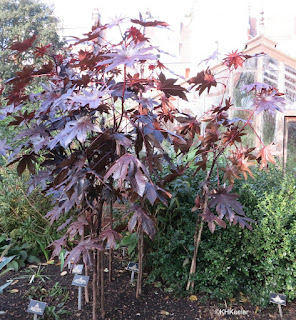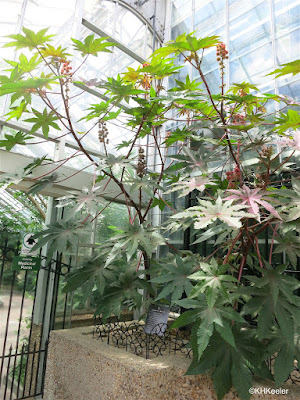 |
| castor, Ricinis communis |
In those days, I was told the plant that castor oil came from was called the castor bean. Although you still see it, the name castor bean is "out" today, because usually beans are plants in the pea family, legumes (Fabaceae) and castor, Ricinus communis, is a spurge, related to croton and poinsettia (Euphorbiaceae). You will see castor oil plant or just castor as we struggle to say it better.
You can see why the name: the seeds do look like beans.
 |
| Seeds of castor, Ricinis communis |
Castor seeds were found in Egyptian tombs dating back about 6,000 years. The oil, quite stable at room temperatures, was apparently used for lamps. But probably also as medicine and in religious applications. Dioscorides (Roman army physician, 64 CE) wrote that castor powder could be used as a purge but was "harsh and extremely laboursome." He did recommend the seed powder laid on externally to cleanse sun burns and to use bruised leaves in boiled grains for various types of swellings.
The seeds have been recognized as poisons for millennia. However, the oil pressed from them was widely used around the Old World, in lamps but also in unguents and as a medicine, especially a mild and reliable laxative. Today, it still is used as a laxative, moisturizer and to reduce inflamation (link, link). Probably, though, it is most important today in industrial applications, for example as an ingredient in soaps, lubricants and coatings.
The only plant in its genus, castor probably originated and was domesticated in tropical east Africa, but it can be documented all over the Old World thousands of years ago: Egypt 6,000 years ago, India 4,000 years ago, China 1,400 years ago.
The scientific name is the Latin word for "tick," which the seeds resemble. I didn't put a scale marker in my photo above, but for midwestern ticks, castor seeds are very large (midwestern ticks). A search of tropical ticks suggests ticks can be much larger than castor seeds (link to tropical ticks) so probably it was a good descriptor for Mediterranean-region ticks.
The plant's common English name castor is the Latin word for beaver. However, that appears to be coincidence. The name castor was apparently applied to Ricinus in the 1700s, in Jamaica, linking it in some way no one explains to Vitex agnus-castus (monk's pepper or chaste tree, mint family Lamiaceae), going from a common name of agnus-castus to castus to castor. Beavers produce a rich oil, castoreum, that was used in perfumes and other cosmetics, back when beavers were common and people were few. Castor oil from the plant and castoreum from the animal are quite different but the names cause confusion. (More about the castor oil and castoreum link).
The Greeks called the plant kika or kiki and the plant kikayon in the book of Jonah in the Bible was probably castor (link link). Its name in India is eranda and it is widely known by versions of that name across southern Asia.
Although known across Europe in the Middle Ages and early Renaissance, castor oil seems to have dropped out of use in England for about 150 years, requiring the seeds from Jamaica in the 18th century to restart its use as a laxative and tonic there, which explains why its current common name came from Jamaica. Before that, it was called ricin, from the Latin name, or more commonly palm of Christ, palma cristi, from the shape of the leaves and the broad healing powers attributed to the oil.
 |
| palma cristi, castor, leaves |
The seeds are explosively released from the pods when they are dry, a characteristic shared with other plants in the spurge family. The plant has escaped to be a roadside weed around the world. The USDA map finds it escaped in 29 states (link) but only Florida and California list it as a problem.
 |
| Castor as weed, in a ditch in Hawaii |
This is a beautiful plant with a very useful oil. The seeds are dangerous and should be handled very carefully.
Comments and corrections welcome.
References
Foster, Steven and R.L. Johnson. 2006. National Geographic Desk Reference to Nature's Medicine. National Geographic Society, Washington, D.C.
Mrs. Grieve. 1932. Castor. in A Modern Herbal. online: link
Lewis, Walter H. and M. P. F. Elvin-Lewis. 2005. Medical Botany. John Wiley and Sons, New York.
Needham, Joseph. 2001. Science and Civilization in China: Volume VI:1. Cambridge University Press, Cambridge.
Patel, Vinay R., G.G. Dumancas, L. C. K. Viswanath, R. Maples and B. J.J. Subong. 2016. Castor oil: properties, uses, and optimization of processing parameters in commercial production. Lipid Insights. 9; 1-12. link
Robertson, John. 2018. The Poison Garden: lots on Ricinis as a poison link
Schmutz, Ervin M. and L. B. Hamilton. 1979. Plants That Poison. Northland Press, Flagstaff, Arizona.
Simpson, Beryl B. and M. C. Orgozaly. 2001. Plants in Our World. 4th edition. McGraw-Hill, New York.
Stewart Amy. 2009. Wicked Plants. Algonquin Books of Chapel Hill, Chapel Hill, North Carolina.
Kathy Keeler, A Wandering Botanist
More at awanderingbotanist.com
Join me on Facebook: https://www.facebook.com/AWanderingBotanist


Nice post, Thank you for sharing valuable information. I enjoyed reading this post. Please Feel Free to Visit haute her tips
ReplyDeleteIts very interesting
ReplyDelete